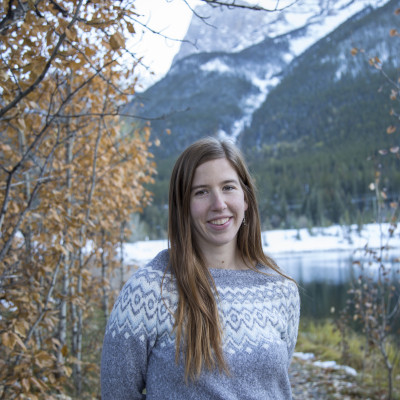
I have always been interested in how the human body functions. Computational chemistry is something I learned about during my undergraduate degree and I think it is a great way to get detailed information about biological systems that is difficult to obtain by other methods.
Where did you grow up? Were you always interested in your current field?
I was born and raised in the beautiful mountain town of Canmore, Alberta, Canada. Nestled in the stunning Canadian Rockies it is full of majestic mountain peaks, iconic turquoise blue lakes and rivers as well as amazing wildlife such as bears, elk, and beavers!
I have always been interested in how the human body functions. Computational chemistry is something I learned about during my undergraduate degree and I think it is a great way to get detailed information about biological systems that is difficult to obtain by other methods.
Are you working from home? If so, how’s it going?
I was working from home during the first few months of the pandemic but have been back on campus at ANU for a bit over a month now. It was a different environment working from home without any other people (or pets) around. I am enjoying being back on campus and being able to collaborate more directly with other members of the research group.
What projects are working on?
My research uses multiscale computer modelling to understand the molecular basis of biological functions. I am working on a few different projects right now that all focus on how compounds enter our cells. This includes a Covid-19 project looking at how the SARS-CoV-2 viral partial enters human cells.
Additionally, I am using computer models to look at how changing the composition of the cell membrane effects its biophysical properties. Membrane composition changes in different tissues, as well as in response to lifestyle choices and in many disease states. Currently computer modelling is the only way to obtain information on membrane properties at high spatiotemporal resolution. Through this work we will be able to better understand one of the key biomolecules of life through unveiling how membrane composition alters membrane properties, which in turn effect the function of the membrane.
I am also involved in a collaborative project that is working to develop a new class of drugs to treat chronic pain. We are looking at a neuronal membrane transporter, GlyT2. The drugs we are developing stop GlyT2 from transporting compounds, lead to inhibiting the pain pathway in the brain.
What do you want people to know about the work that you do?
The computational models we investigate provide us with atomic level details that help us to understand how biological systems work, including designing drugs to modulate their function. When combined with traditional experimental methods we are able to get a more complete understanding of the system than either method can obtain in isolation.
Why do you love what you do?
I love the collaborative aspects of my work and the novel insights we are able to get into how biological systems work. I find it fascinating to look at the atomic level details of biomolecules as a way to understand how the systems work.
What is one specific thing that you have achieved (research or otherwise) that you are most proud of?
I am most proud of the aspects of my work that have made a difference to others. This includes things such as helping a students to better understand a concept, scientific outreach that changes someone’s perspective and the scientific work I have done that has provided novel insights.
One project that provided a particularly exciting outcome as a computational chemist, is the molecular dynamics simulations I used to investigate how a specific clinical point mutation to an adhesion protein changes the protein's ability to bind to its substrate. This work provided the first evidence that this mutation leads to a loss of function of the protein and based on my findings, an Australian family is now receiving government support for their child who has intellectual disabilities.
